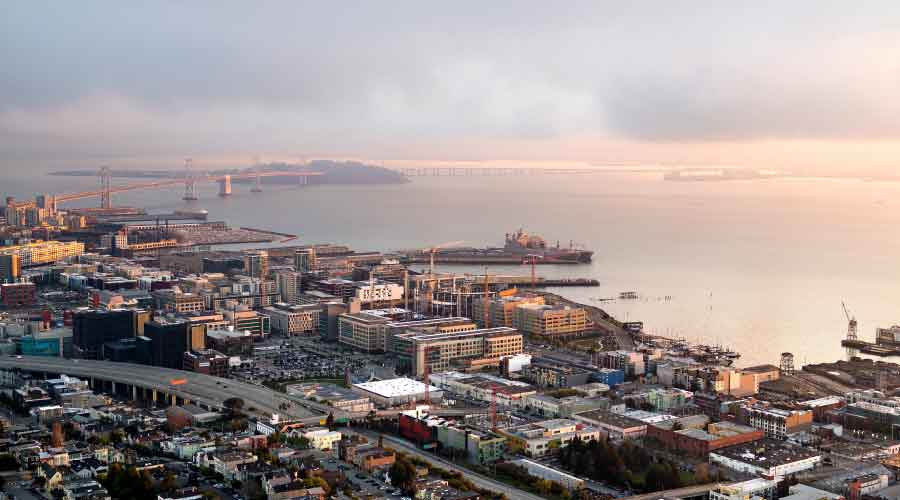 San Francisco’s Mission Bay neighborhood
San Francisco’s Mission Bay neighborhoodSan Francisco Building Owners Sue City Over Sinking Sidewalks
The sidewalks have been steadily deteriorating and building owners and the city are at an impasse on responsibility for addressing the problem.
By Tyler P. Berding, Esq. and Daniel Rottinghaus, Esq., contributing writers
San Francisco’s Mission Bay neighborhood sits on what once was a tidal lagoon and marsh on the edge of San Francisco Bay. Starting in the mid-1800’s, it became a convenient dumping ground for city refuse, as well as rubble from the 1906 San Francisco earthquake. Eventually the area was filled and used mostly for industry and rail yards. Land being worth what it is in San Francisco, the Board of Supervisors in conjunction with a master developer, entitled the area for a large re-development project. Construction of this new urban area began twenty years ago. The Golden State Warriors built Chase Center on one parcel and the University of California San Francisco hospital and Uber’s headquarters were built on others. Other developers acquired parcels and built condominium and office buildings. The sidewalks and streets, and the public utilities beneath the streets, were dedicated to the City of San Francisco to maintain.
Soon after some buildings were constructed, it was noticed that while the buildings remained stable, the sidewalks and streets around them had subsided. Experts have said because the buildings are built on deep piles drilled into bedrock, they don’t move, but the surrounding streets and sidewalks and the infrastructure beneath them are gradually settling as the old bay fill settles. As a result of the subsidence of the bay mud, the roadways, sidewalks, and parks are sinking and pulling away from the buildings causing deep cracks, uneven pavement, and improper drainage courses. The sinking was projected when construction started to be as much as 24 inches. This is not an insignificant amount when you consider the impact on stairs, walkways and other entrances from sidewalks to buildings. And while this projected subsidence was accommodated in the design of the building foundations, it was ignored in the publicly owned infrastructure settling while the buildings are not.
The city of San Francisco is now trying to force the building owners to correct the city’s problem. That the city and its redevelopment agency view the issue as one to be addressed by the private property owners is reflected in this Notice of Violation posted to the door of one building.
This notice focuses on cracked and sunken sidewalks. But the experts say the damage is caused by the subsidence of the city-owned fill beneath the sidewalks and the streets. Replacing cracked sidewalks over the same subsiding bay fill merely postpones a permanent solution.
After numerous informal attempts to get the City of San Francisco to address the problem, the owners’ association of one of the condominium buildings in Mission Bay stepped forward to represent all the property owners, including the 1900 affordable housing residents in the area who cannot help themselves. The plaintiff owners’ association has filed a complaint in San Francisco Superior Court. The owners are asking for the city’s assistance in solving this problem. Their lawsuit seeks to benefit the community, visitors to the area, workers, and other building owners. While the subsidence is an eyesore and hurts property values, the real problem is the permanent damage to sidewalks and streets, access to buildings, and underground utilities like sewer, water, electric and gas lines all damaged by the sinking weight of the streets above. It is a problem affecting the whole community. The problem will not self-correct, so the lawsuit seeks a solution today that will obviate a potential disaster tomorrow.
The building owners’ claim is not about pointing fingers or assessing blame. The Mission Bay development was a collaborative approach between government and those governed—the owners of Mission Bay property. The lawsuit is framed to again encourage a collaborative approach to achieve an appropriate long-term resolution. The claimants are not looking for a handout, they are demanding a hand from the City of San Francisco. This is a problem, not just for the owners of Mission Bay property, but for all the taxpayers in San Francisco. It is hoped that the city will see its way clear to joining with the owners to find an acceptable solution.
Tyler Berding, founding partner of Berding & Weil LLP, has represented the commercial and residential real estate industry since 1974.
Daniel Rottinghaus is a litigation partner and represents commercial and residential real estate clients in construction defect and complex litigation.
Related Topics:












